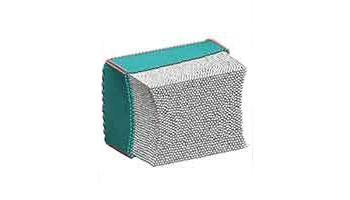 Hydrogen (white) is packed into a tiny box made of graphene, which
Hydrogen (white) is packed into a tiny box made of graphene, which researchers at the University of Maryland in College Park can open and
close using electricity. (Credit: Maryland NanoCenter)
Shuze Zhu and Teng Li, of the Department of Mechanical Engineering at the University of Maryland, have found that they can make tiny squares of graphene fold into an origami box and store hydrogen in it.
Like diamond or graphite, graphene is a structural modification (an allotrope) of carbon, that has many special properties that make it a very useful material with great potential for application in technology. In essence, graphene is an isolated atomic plane of graphite, which is very light (1-square-meter sheet weighing only 0.77 milligrams) and at the same time very strong (graphene has a breaking strength over 100 times greater than a hypothetical steel film of the same thickness).
The malleable nature of atomically thin graphene makes it a potential candidate material for nanoscale origami, a promising bottom-up nanomanufacturing approach to fabricating nanobuilding blocks of desirable shapes. The success of graphene origami hinges upon precise control of graphene morphology, which still remains as a significant challenge.
Now, Shuze Zhu and Teng Li have demonstrated a so-called hydrogenation-assisted graphene origami, or more specifically, a box which will open and close itself in response to an electric charge. Inside the box, they’ve tucked hydrogen atoms, and have done so more efficiently than was thought possible.
The U.S. Department of Energy is searching for ways to make storing energy with hydrogen a practical possibility, and they set up some goals: by 2017, the Department had hoped that a research team could pack in 5.5 percent hydrogen by weight, and that by 2020, it could be stretched to 7.5 percent.
Li’s team has already crossed that threshold, with a hydrogen storage density of 9.5 percent hydrogen by weight. The team has also demonstrated the potential to reach an even higher density, a future research goal.
“Just like paper origami that can make complicated 3-D structures from 2-D paper, graphene origami allows us to design and fabricate carbon nanostructures that are not naturally existing but of desirable properties,” said Li an Associate Professor of Mechanical Engineering, and a member of the Maryland NanoCenter, UMERC and a Keystone professor in the A. James Clark School of Engineering. “We have made nano-baskets, as well as these new nano-cages to hold hydrogen and other molecular cargos.”
Zhu, S., & Li, T. (2014). Hydrogenation-Assisted Graphene Origami and Its Application in Programmable Molecular Mass Uptake, Storage, and Release ACS Nano DOI: 10.1021/nn500025t
